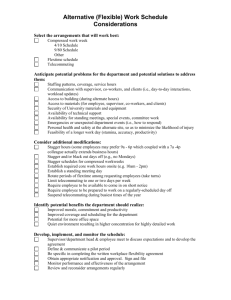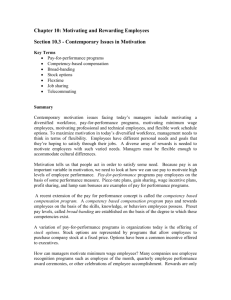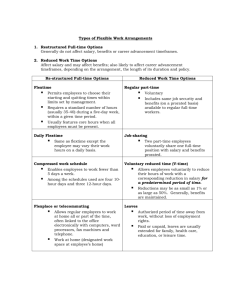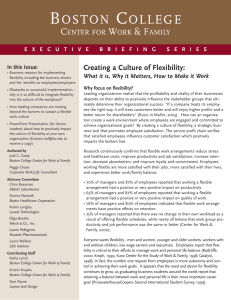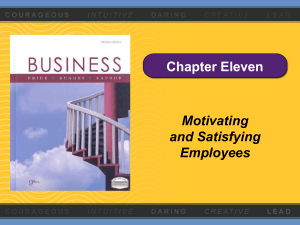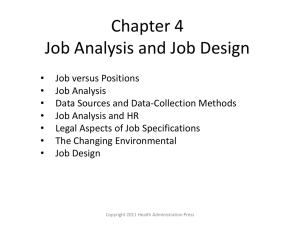P Measuring the Impac t of WORKPL ACE FLE XIBILIT Y
advertisement
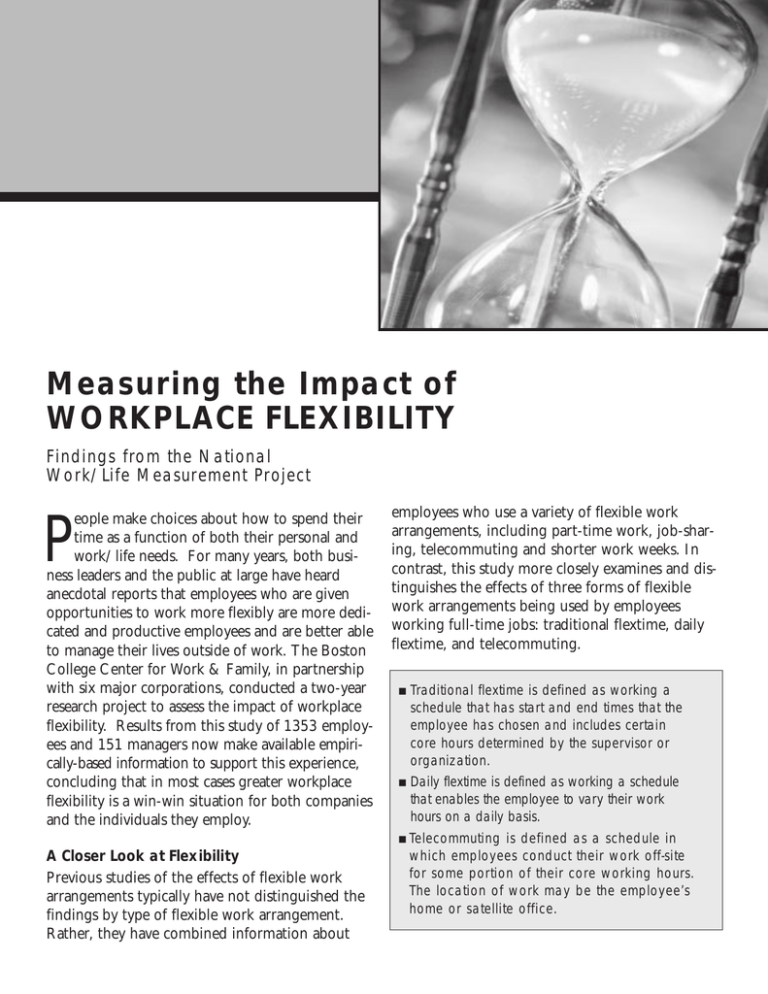
Measuring the Impac t of WORKPL ACE FLE XIBILIT Y Findings from the National Work/Life Measurement Project P eople make choices about how to spend their time as a function of both their personal and work/life needs. For many years, both business leaders and the public at large have heard anecdotal reports that employees who are given opportunities to work more flexibly are more dedicated and productive employees and are better able to manage their lives outside of work. The Boston College Center for Work & Family, in partnership with six major corporations, conducted a two-year research project to assess the impact of workplace flexibility. Results from this study of 1353 employees and 151 managers now make available empirically-based information to support this experience, concluding that in most cases greater workplace flexibility is a win-win situation for both companies and the individuals they employ. A Closer Look at Flexibility Previous studies of the effects of flexible work arrangements typically have not distinguished the findings by type of flexible work arrangement. Rather, they have combined information about employees who use a variety of flexible work arrangements, including part-time work, job-sharing, telecommuting and shorter work weeks. In contrast, this study more closely examines and distinguishes the effects of three forms of flexible work arrangements being used by employees working full-time jobs: traditional flextime, daily flextime, and telecommuting. ■ Traditional flextime is defined as working a schedule that has start and end times that the employee has chosen and includes certain core hours determined by the supervisor or organization. ■ Daily flextime is defined as working a schedule that enables the employee to vary their work hours on a daily basis. ■ Telecommuting is defined as a schedule in which employees conduct their work off-site for some portion of their core working hours. The location of work may be the employee’s home or satellite office. The Case for Daily Flextime Results reveal that the most promising form of flexibility is daily flextime. While there is still a place for more traditional forms of flexible work arrangements, companies can be even more successful by embracing a broader commitment to flexibility. The same dynamics that are requiring companies to be more nimble in the marketplace hold true for today’s workforce. The world is more complicated, the pace of life has dramatically quickened, and demands on time are greater. Companies have found they need to be much better equipped to adapt quickly to this changing world, and employees are coming to the same conclusion. Companies that create work environments allowing for this daily flexibility are finding that their commitment is paying off. Employees using daily flextime are more likely to say that this flexibility has a positive impact on their productivity, quality of work, and their plans to stay with the company. For individuals, the findings are equally exciting. Employees working flexibly are more satisfied with their jobs, more satisfied with their lives, and experience better work/family balance. The Challenges of Telecommuting Experts in the area of telecommuting have long warned of the potential problems with telecommuting, if not managed appropriately. The data gathered through this study confirm that telecommuting arrangements, as they are typically construed, pose the greatest number of problems for employees relative to other forms of flexible work arrangements. Compared with both daily flextime and traditional flextime users, telecommuters work more often while on vacation, rate their work/life balance and life satisfaction significantly lower, believe they have more negative relationships with their managers and co-workers, and are less committed to their jobs. Compared to managers who supervise telecommuters, employees who telecommute are less likely to report that they are viewed as committed to their jobs, and are more likely to believe that they do not get the same challenging assignments as other workers. In contrast, managers who supervise telecommuters are more likely than employees who Boston College Center for Work & Family, October 2000 telecommute to believe that telecommuting has negative effects on employee-supervisor relationships, and are less likely to feel that telecommuters get the same promotions and performance reviews as other employees. Project Background The Boston College Center for Work & Family conducted this research in collaboration with six companies: ■ Amway Corporation ■ Bristol-Myers Squibb Company ■ Honeywell ■ Kraft Foods ■ Lucent Technologies ■ Motorola, Inc. This study is unique for several reasons. First, as a cross-company study, the project provides first-of-itskind comparative data about the impact of flexible work practices in different industries. Second, by including information from both users and nonusers of flexible work arrangements, the study is uniquely positioned to examine perspectives of diverse team members. Third, because the study included reports from managers as well as employees using flexible work arrangements, it provides the opportunity to examine the more far-reaching effects of flexible work arrangements. Data for the study were collected using surveys, in-depth personal interviews, and focus groups, allowing for meaningful analysis of both quantitative and qualitative responses. STUDY HIGHLIGHTS Impact on Companies According to both users of flexibility and their managers, there are several business-related advantages of flexible work practices, most notably in the areas of productivity, quality of work and retention. Productivity 70% of managers and 87% of employees reported that working a flexible arrangement had a positive or very positive impact on productivity. Quality of Work 65% of managers and 87% of employees reported that working a flexible arrangement had a positive or very positive impact on quality of work. Retention 76% of managers and 80% of employees indicated that flexible work arrangements have positive effects on retention. Telecommuting There were striking differences in the experiences of employees using telecommuting and those using either daily flextime or traditional flextime. These include: ■ 46% of telecommuters reported working while on vacation, compared to 34% of non-users, 30% of daily flextime users, and 28% of traditional flextime users. ■ 24% Impact on Managers In addition to overall positive outcomes for the companies, the direct managers of employees working flexibly reported favorable results in relation to their own work. 75% of managers reported no change in their own workload, while nearly all believe that work group productivity and their job performance was the same or better. Impact on Employees Users of both daily flextime and traditional flextime reported many positive outcomes. In most instances, employees using daily flextime were most positively impacted while telecommuters reported the least positive effects. Work-Life Balance Users of traditional flextime and daily flextime reported better work/life balance than both nonusers and telecommuters. Daily flextime users reported the best scores, with 38% of this group indicating that their work/life balance was "good" or "very good," compared to 31% of traditional flextime users, 26% of non-users and 24% of telecommuters. Life Satisfaction Workers using daily flextime reported the highest life satisfaction scores, with 65% of daily flextime users saying they were satisfied or very satisfied, compared to 58% of non-users and 46% of telecommuters. of telecommuters rated their work/life balance as "good" or "very good" compared to 26% of non-users, 38% of daily flextime users, and 31% of traditional flextime users. ■ 46% of telecommuters said they were "satisfied" or "very satisfied" with their lives, compared to 58% of non-users, 65% of daily flextime users, and 61% of traditional flextime users. The statistics above examine the impact of telecommuting on the lives of employees outside of work. In terms of career-related issues, there were also some interesting findings, with frequent differences in perception between managers and employees. Managers and employees agree that: ■ Telecommuters are less likely to get the same salary increases as other employees. ■ Telecommuters are less likely to have positive relationships with their co-workers. However, a greater percentage of managers who supervise telecommuters than telecommuters themselves believe that telecommuters are: ■ More likely to have negative or neutral relationships with their supervisors than other flextime users. ■ Less likely to get good performance reviews. ■ Less likely to get promotions. On the other hand, a greater percentage of telecommuters than managers who supervise telecommuters believe that telecommuters are: ■ Less likely to receive the same challenging assignments as employees not using these arrangements. ■ Less Boston College Center for Work & Family, October 2000 committed to their jobs. While these findings highlight the experience of individual employees, results related to the business impact are considerably more favorable. There were no significant differences between telecommuters and other users of flexibility on questions of attachment to the company, quality of work, or productivity, with high scores in each of these areas. Perceptions of Non-Users While most employees who were not using flexible work arrangements believe that employees using flexible arrangements are just as committed to their jobs as other workers, non-users expressed some significant concerns. For example, 35% of nonusers believe that their co-workers who use flexible work arrangements cause resentment among those working on-site, 48% say that it is more difficult to work collaboratively with employees who use flexible work arrangements, and 30% believe that it is more difficult for supervisors to communicate with employees who use these arrangements. Implications for Companies In summary, this study presents a “good news/bad news” scenario related to workplace flexibility, with the good news potentially far more positive than the bad news is negative. We arrive at this conclusion based on the fact that many of the problem areas relate to issues of perception, either between users and non-users or managers and employees. Companies proactively investing in the actual management of these work arrangements — addressing head-on issues such as communication, equity, and clarity of objectives — will likely reap far better results than companies failing to attend to these issues. These efforts, combined with a company-wide commitment to daily flexibility, should have tremendous implications for the long-term success of the flexible workplace. r About the Center The Boston College Center for Work & Family is a research organization within the Carroll School of Management that promotes employer responsiveness to families. The Center’s guiding vision is to serve and the bridge linking the academic research community to the workplace. To gain increased understanding of the challenges faced by both employees and employers in meeting the goals of the individual and the enterprise, the Center conducts basic and applied research studies and analyzes secondary information sources. The Center’s initiatives fall into three broad categories: research, employer partnerships, and information services. Boston College Center for Work & Family, Wallace E. Carroll School of Management, 140 Commonwealth Avenue, Chestnut Hill, MA 02467. For more information on the Center, or to order copies of the full report, please contact us at: (phone) 617-552-2844, (fax) 617-552-2859, www.bc.edu/cwf
